Quick and easy, this New York Strip Steak recipe uses the classic sear-and-bake method to get the best moist and tender steaks every time. Trim and season, then a fast pan sear and finish to final temperature in the oven.
🐄Ingredients
New Your Strip Steaks—about 1 inch thick, choice or prime grade
Seasoning—salt, black pepper, garlic powder
Optional seasoning—marinades, thyme, rosemary, or other herbs and spices
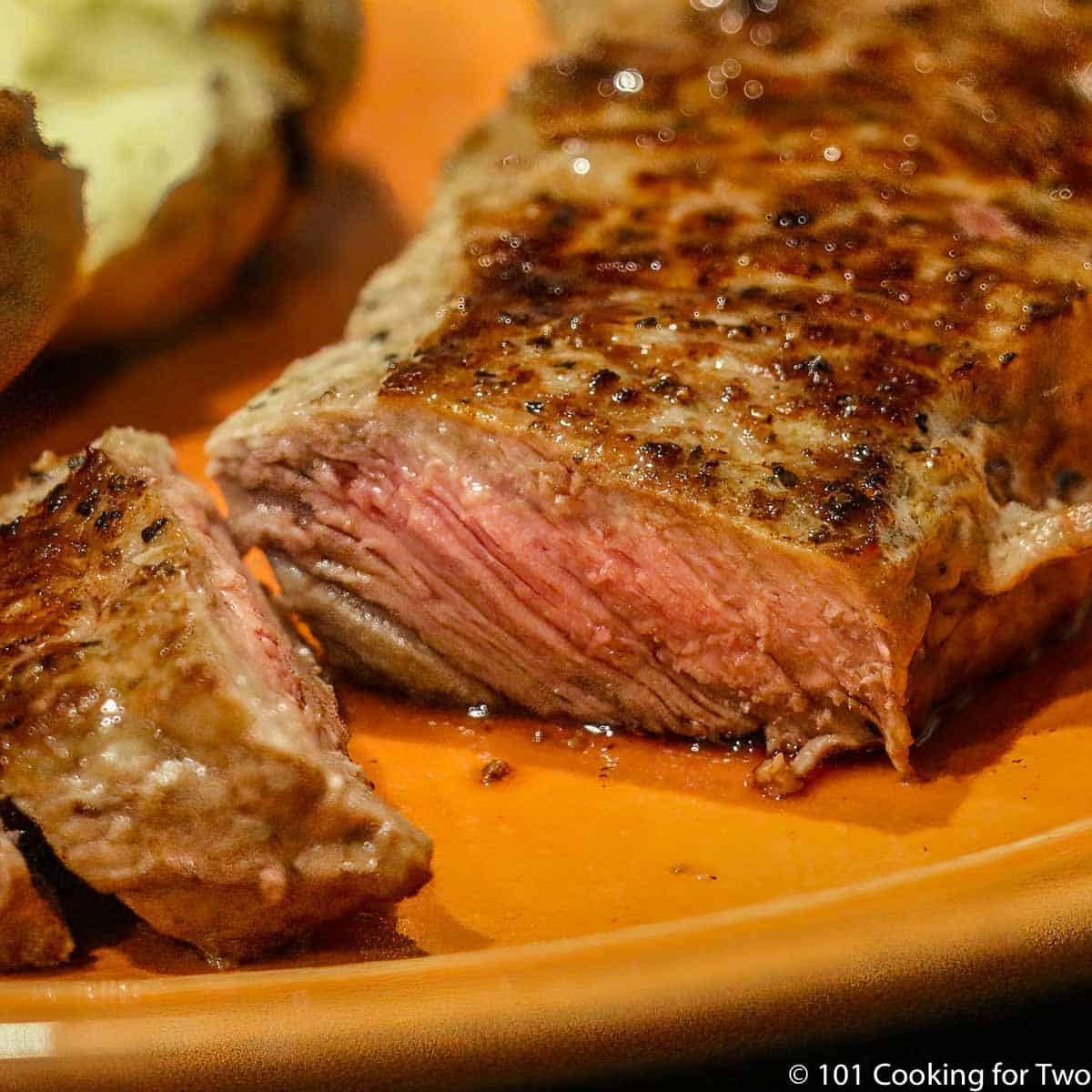
Jump To (scroll for more)

Featured Comment from Colleen:
"5 stars—I made this for my family tonight. I got 5 STARS from even the pickiest eater."
Cook like the best steakhouses. Searing steak in a cast-iron skillet will give you the wonderful flavor of the Millard reaction. Then, finish the steak in the oven to your desired temperature.
Learn the sear and bake technique with easy step-by-step photo instructions—a foolproof recipe for moist and tender steak every time. For equally great results on the grill, check out How to Grill New York Strip Steak on a Gas Grill.
👨🍳How to Cook a New York Strip Steak—Step-by-Step Photo Instructions
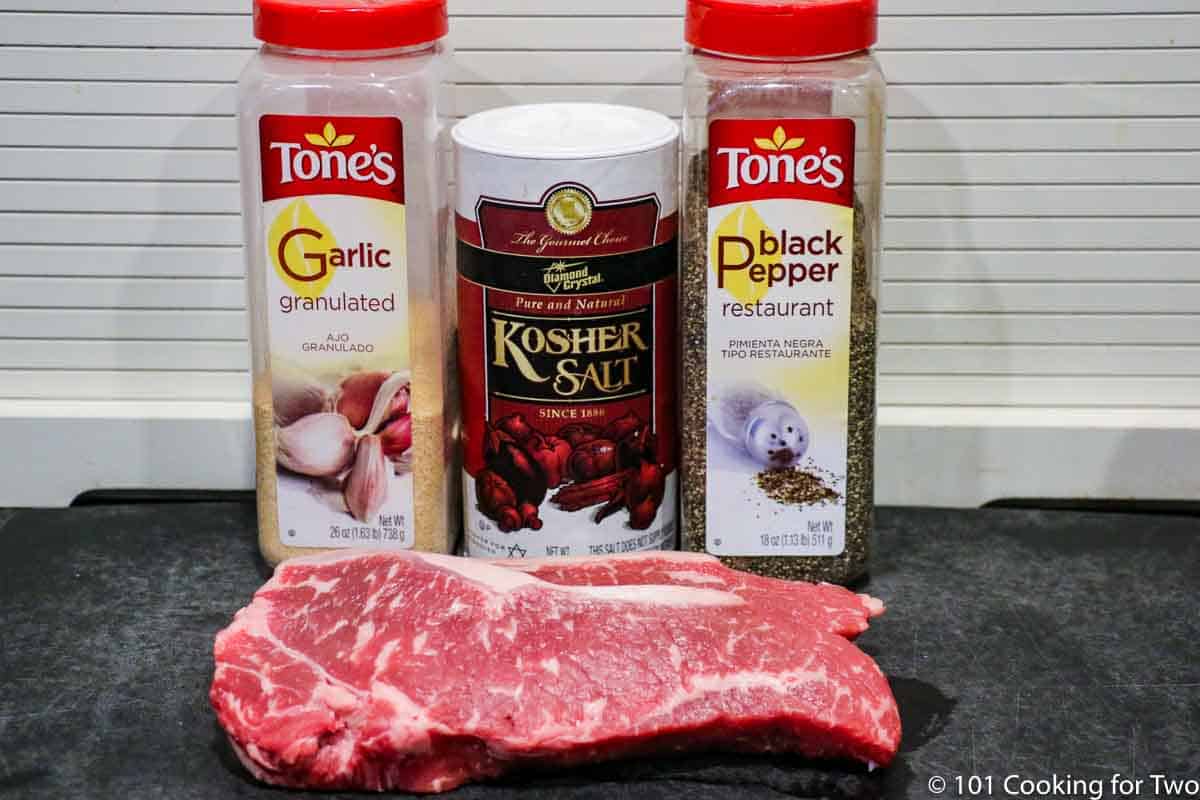
1. Allow the steaks to rest at room temperature for 30-60 minutes.
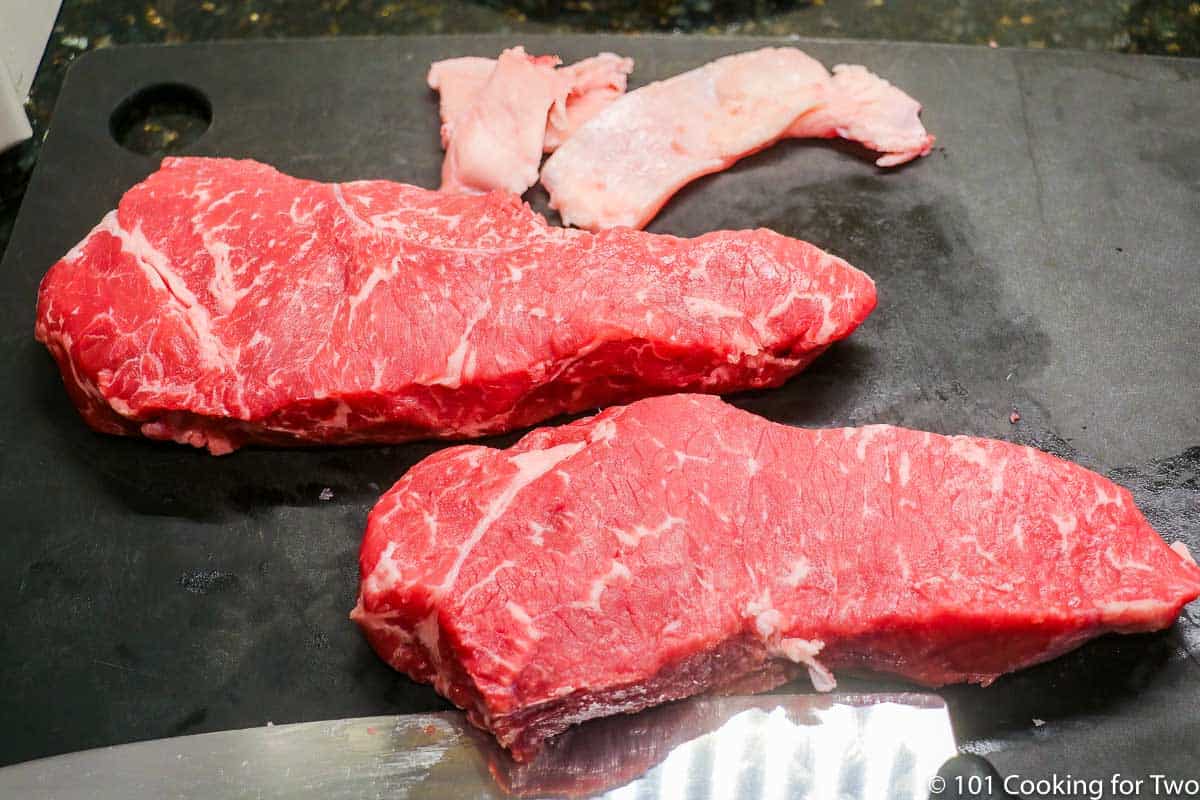
2. Trim any easily trimmable edge fat. Pat dry with paper towels.
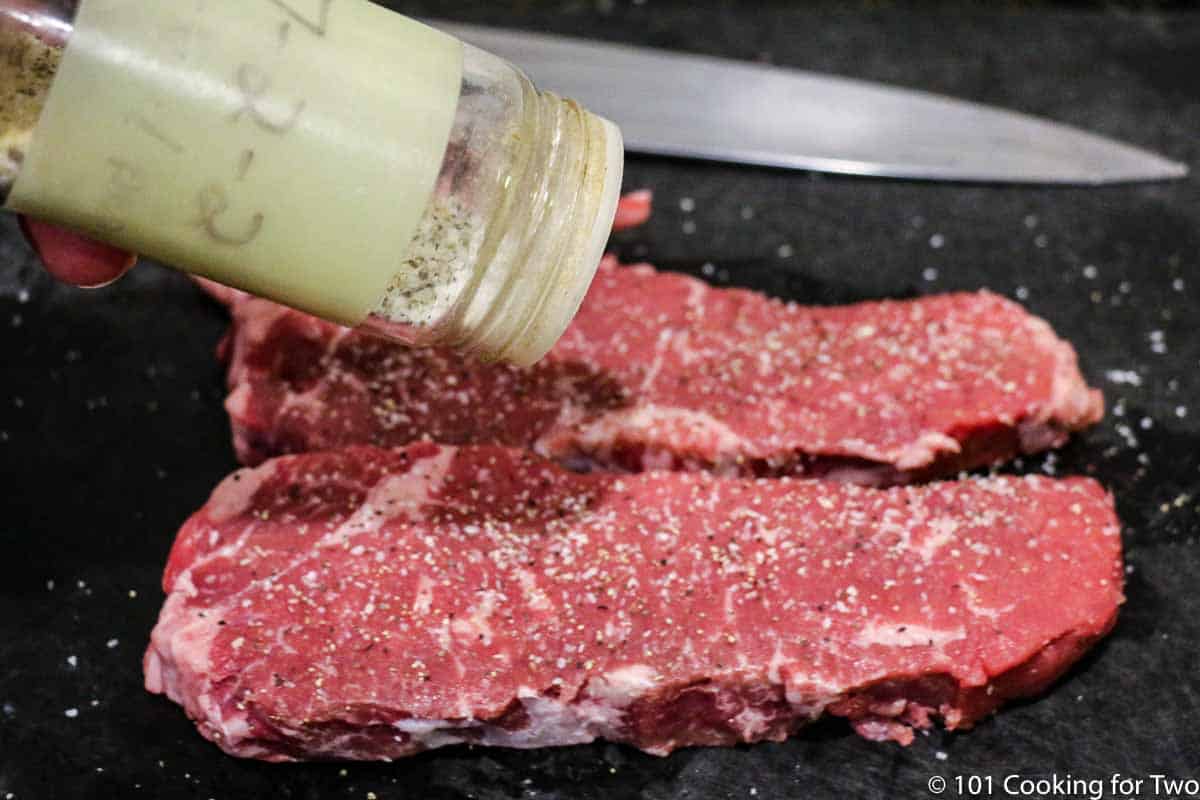
3. Season to your taste.
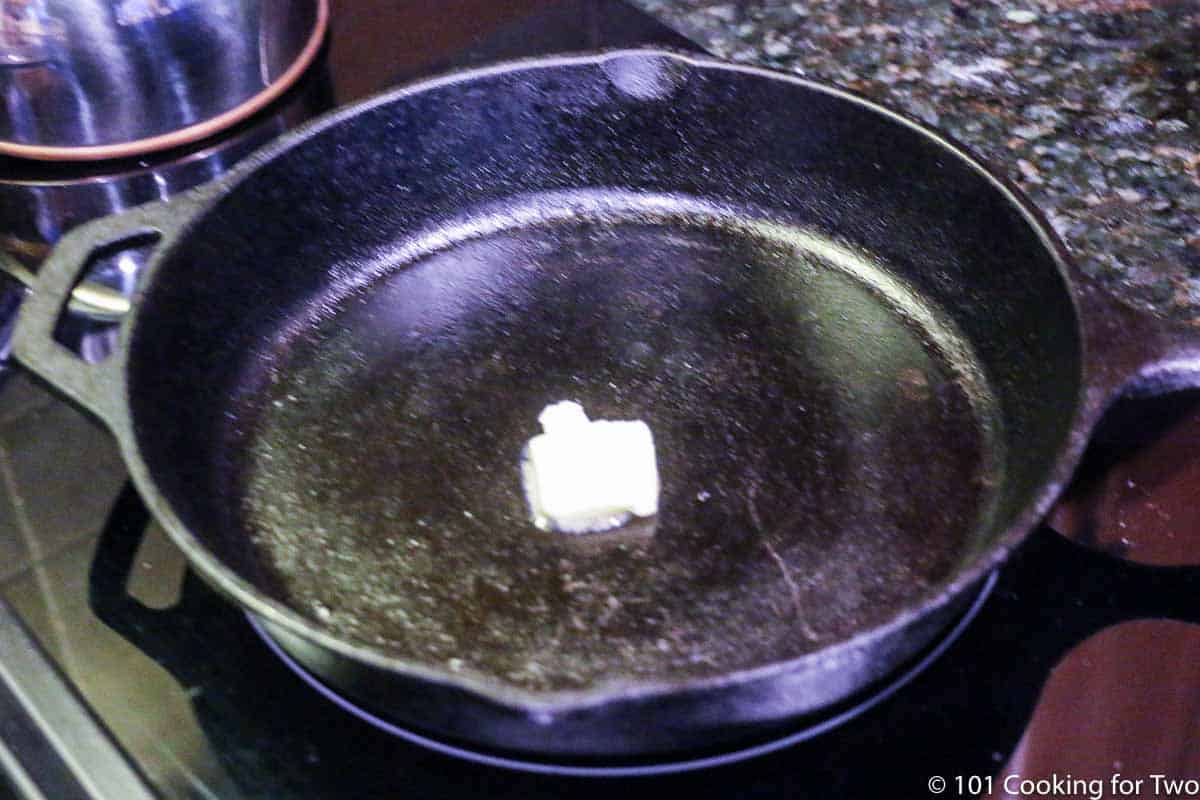
4. Melt butter in a cast-iron or other oven safe pan..
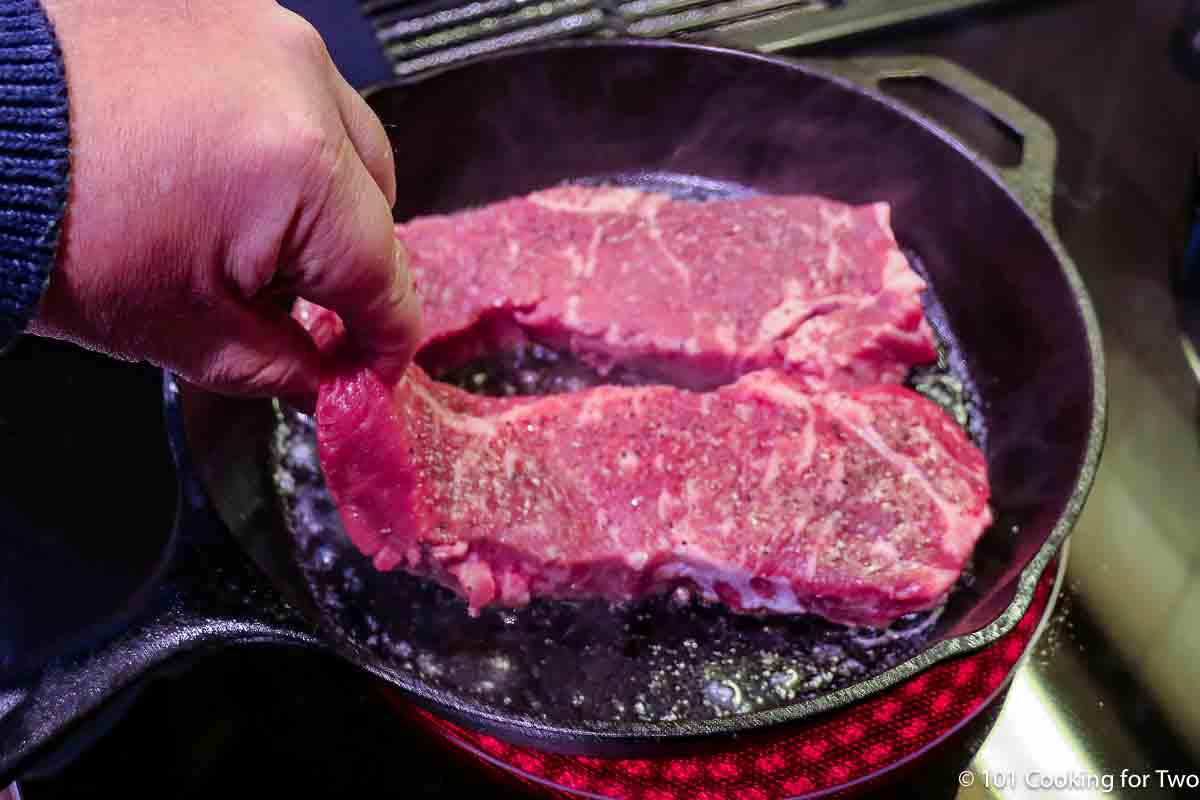
5. When the pan is hot, add the strip steaks.
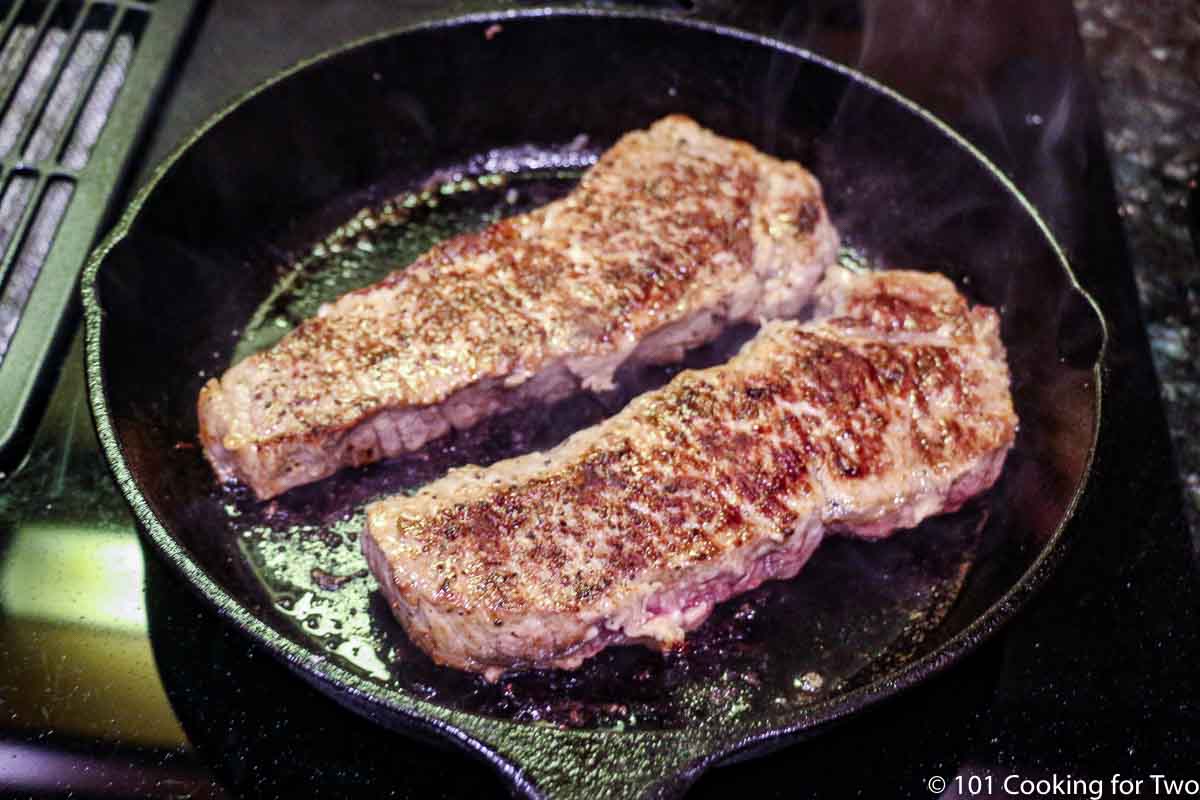
6. Sear both sides of the steaks for about 2 minutes each.
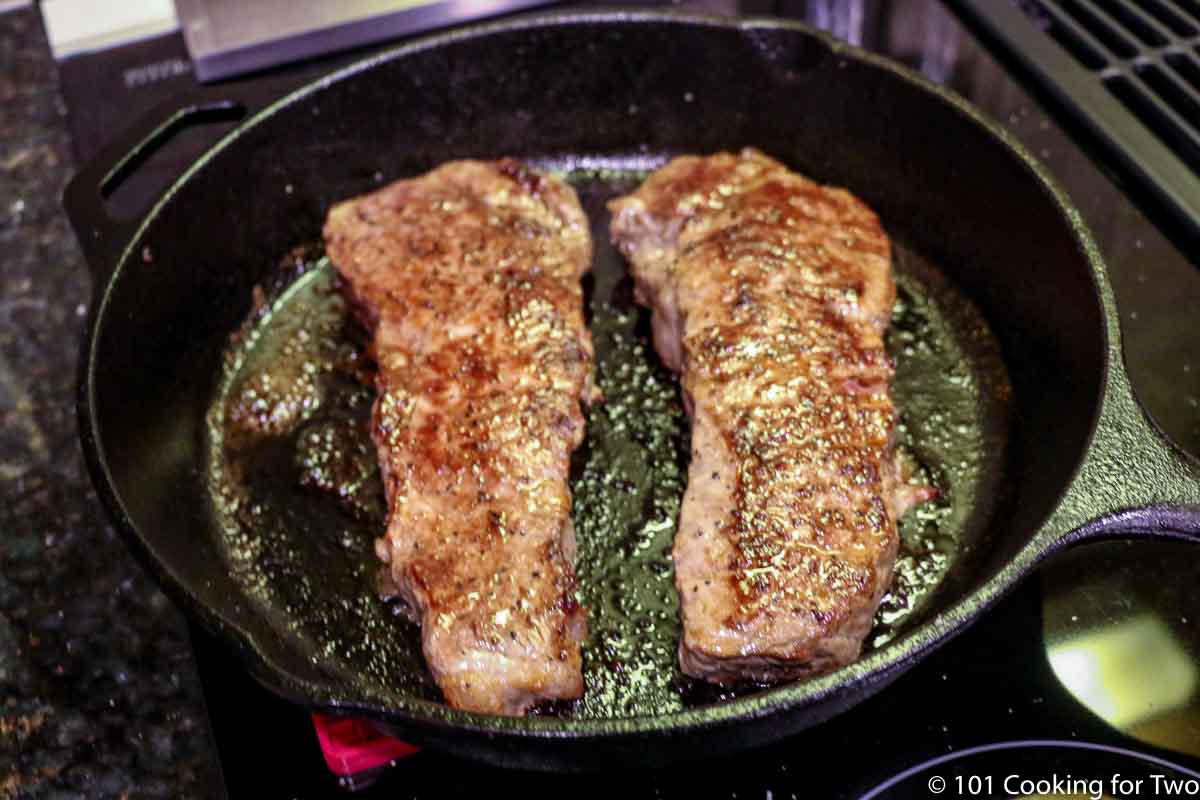
7. Move to a 400° oven. Cook to the final temperature minus a few degrees—about 5 to 7 minutes to reach 130-135° (medium-rare) or 7 to 9 minutes for 140°-145°
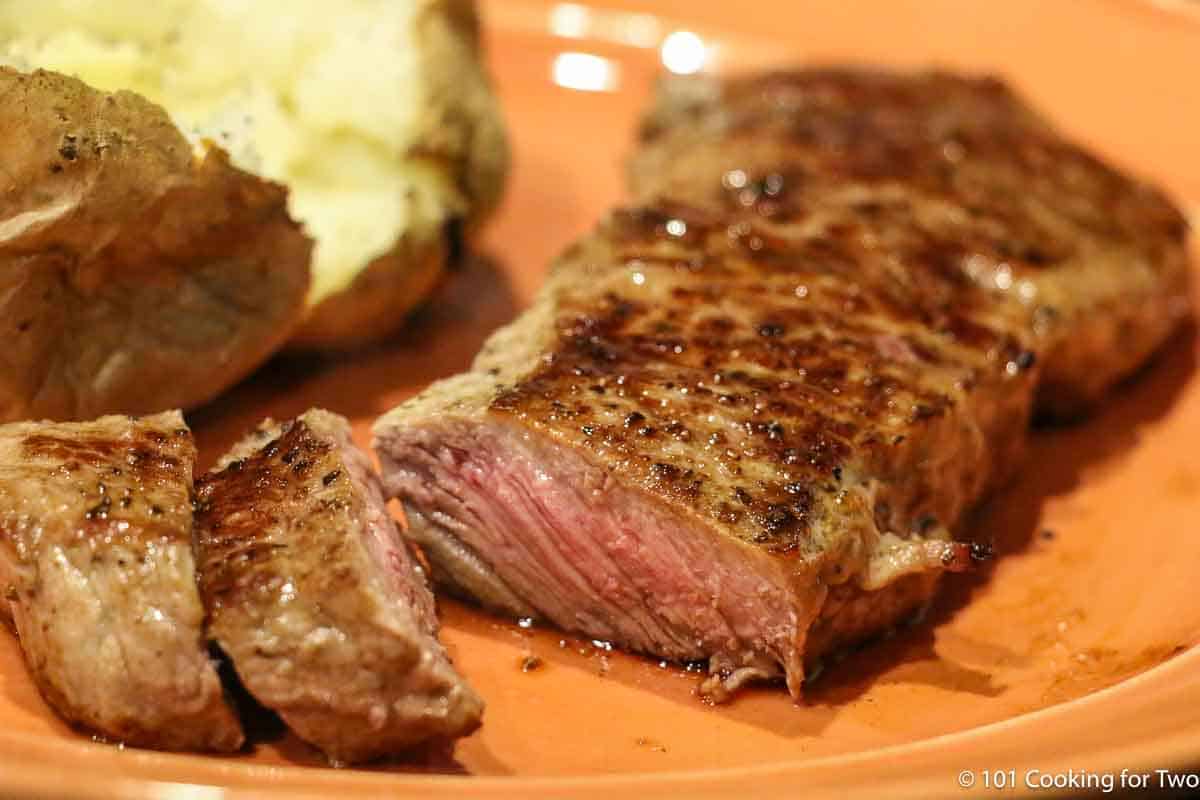
8. Remove from the oven, tent with foil, and allow to rest for a few minutes before serving.
For more details, keep reading. See the Recipe Card below for complete instructions and to print.
⏰How long to cook strip steaks in the oven
Total cooking time for a 1-inch NY strip steak to 140° (medium) is about 11-12 minutes, including a 4-minute sear and 7-8 minutes in a 400° oven when rested to room temperature first. For medium-rare (130°-135°), decrease the oven time to 5-7 minutes.
Approximate oven cooking time for strip steaks
Rare—cold red center(125°-130°)—4-minute sear and 2-4 minutes oven time for about 6-8 minutes total cooking time. It may be almost no time in the oven if you did an intense sear with a rest to room temperature or if your steaks are thinner.
Medium rare—warm red and soft center(130°-135°)—4-minute sear and 5-7 minutes oven time for about 9-11 minutes total cooking time.
Medium—pink and firm (140°-150°)—4-minute sear and 7-9 minutes oven time for about 11-13 minutes total cooking time.
Medium well—minimal pink(150°-155°)—4-minute sear and 9-11 minutes oven time for about 13-15 minutes total cooking time.
Well done—firm and brown(160°+ )—4-minute sear and 12-15 minutes oven time for about 16-19 minutes total cooking time.
The best oven temperature is 400° convection or 425° conventional. You can use 350° or 375°, but you must accommodate the cooking time.
Variables affecting cooking time are the rest's length at room temperature, the thickness of the steak, oven temperature, and the length of the sear. Remember, you can cook your steak more if needed, but you can not uncook a steak.
NEVER COOK BY TIME ALONE; cook to your target internal temperature. Please check the internal temperature a few minutes early. Stop cooking a few degrees before to allow the temperature to rise during the rest before serving.
🧂Seasoning and marinades
Coarse salt and black pepper are all you need. Others like to use commercial mixes like Montreal Seasoning. We like to use our All-Purpose Seasoning Recipe, which adds garlic. Thyme, rosemary, or other herbs may also be used to add different flavors.
A marinade will make your special meal stand out. One of our favorite company meals is marinade New York strip steaks using our easy steak marinade. Or try a rub, like Coffee Steak Rub.
✔️Tips to cook strip steaks right every time
Quality matters in the steaks you buy—use Prime or Choice grade.
A 1-inch strip steak will be about 12 ounces, while a 1 ½ inch is over a pound. This method works well between ¾ to 1 ½ inches thick. Over 1 ½ inches thick should be cooked with a reverse searing method.
Bone-in strip steak can be used, but realize it will take a bit longer to cook.
The timing of seasoning is important. Salt will pull fluid out of meat, but it will reabsorb in about an hour. So, any salt-containing seasoning should be applied 1 hour before cooking or just before cooking to get the moistest steaks.
Resting before serving allows the fluid that escapes the cells during cooking to migrate back into the cells and make for a moist and tender steak.
Related steak recipes
For the other way to cook great strip steaks, see Grilled NY Strip Steaks. Or see Grilled T-bone Steaks, Grilled Filet Mignon, or Pan Seared Filet Mignon.
What to serve with strip steak?
We love a potato side dish—baked, twice-baked, or smashed potatoes are great compliments. Check out Roasted Red Potatoes, Crispy Parmesan Baked Potatoes, or Twice Baked Potatoes.
Other vegetables like broccoli, asparagus, or green beans are simple ways to round out your meal. Green Beans with Bacon, Baked Parmesan Asparagus, and Parmesan Roasted Cauliflower are some good choices.
Leftovers
Store leftovers in an airtight container or ziplock bag in the refrigerator for 4 days or frozen for 3-4 months.
I like to use cold leftover strip steak cut up for a salad topping. Or you can reheat it in a microwave, stovetop, oven, or air fryer.
🐄What is a Strip Steak?
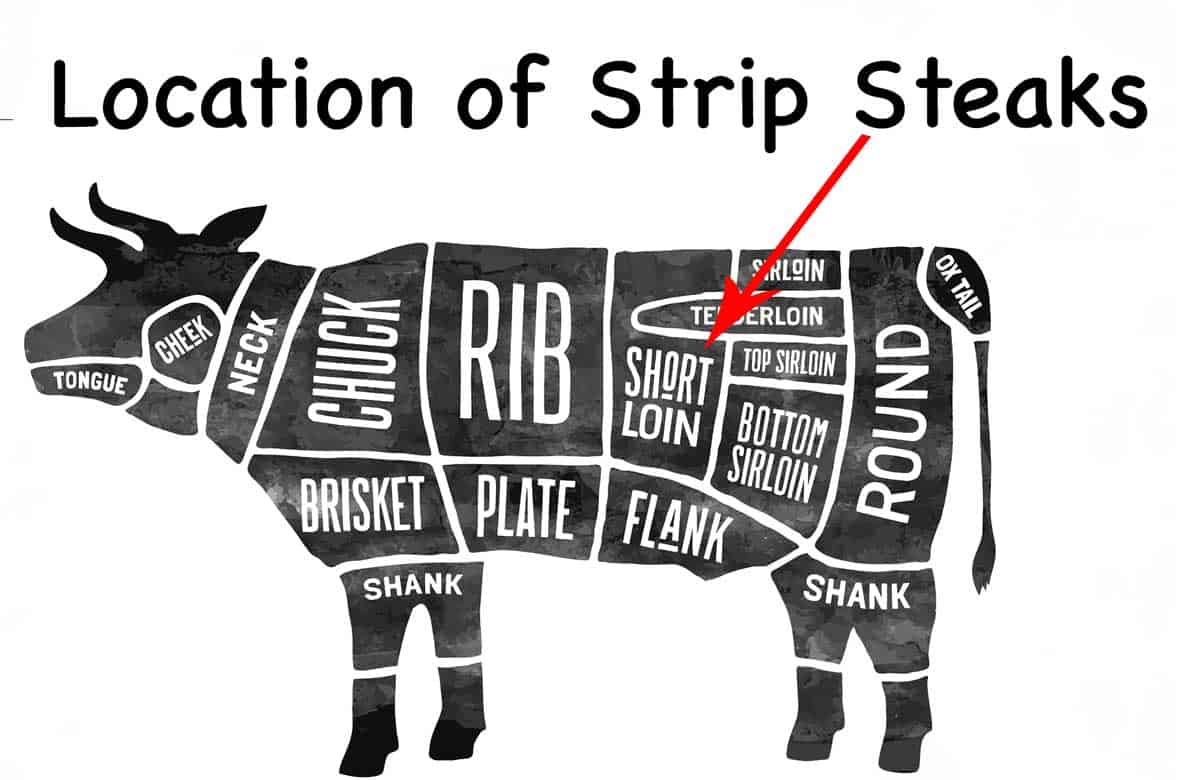
Strip steaks are part of the short loin behind the rib area with the tenderloin. Specifically, strip steaks come from the longissimus muscle, which does little work but has a fair amount of fat that helps make them tender.
Strip streaks are frequently called New York (NY) strip steaks, Kansas City strip steaks, or striploin steaks.
❓FAQs
We will pair the strip steaks with Cabernet Sauvignon, Merlot, or Pinot Noir for an excellent wine complement.
Cast iron is perfect for searing breaking steaks in the oven. It transfers heat evenly across the entire surface without hot spots. It will also hold the heat well and is excellent when going from the stovetop to the oven.
All home cooks should have a cast-iron skillet. They are cheap, easy to maintain, and will last generations. It can also tolerate any heat from a stovetop, oven, or grill you can generate at home.
The pan to sear steaks does not have to be cast iron; any oven-safe pan that can move from stovetop to oven will do. If you don’t have any pan that will work, sear in a stovetop pan and move to a different preheated oven-safe pan to finish.

This recipe is listed in these categories. See them for more similar recipes.
Have you tried this recipe, or have a question? Join the community discussion in the comments.
👨🍳Recipe
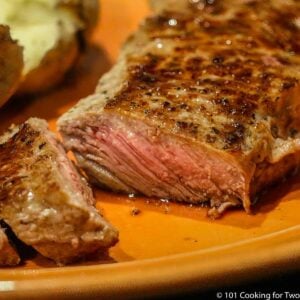
Pan Seared Oven Roasted Strip Steak
Video Slideshow
Save this recipe to your inbox for later!
You may recieve the email without subscribing if you wish, but the subscription is convienent and has an easy one-ckick unsubscribe.
Ingredients
- 2 New York strip steaks - 1 inch thick
- salt and pepper to taste - or season to taste
Instructions
- Allow the steaks to rest at room temperature for 30-60 minutes if you have time—preheat the oven to 400° convection or 425° conventional oven.
- Trim any easily trimmable edge fat. Pat dry with paper towels. Season to your taste. A good sprinkle of black pepper and Kosher salt is all you need, but I use 7:2:2 (my homemade seasoning).
- Melt 1 tablespoon of butter or use oil in an oven-safe pan (cast-iron preferred) over medium-high heat. Some prefer oil due to butter's lower smoke point, but I have never had a problem with either.
- When the pan is hot, add the strip steaks. Sear both sides of the steaks for about 2 minutes each. Sear until they are close to the final color you want.
- Transfer the pan to the preheated oven. Now comes the variables: the steak thickness, how long you seared it, and the oven's actual temperature. Cook to the final temperature minus a few degrees—the steaks will rise a few degrees during the rest after cooking.
- Bake for about 5 to 7 minutes to reach 130-135° (medium-rare) or 7 to 9 minutes for 140°-145° (medium). Remove from the oven, tent with foil, and allow to rest for a few minutes before serving. COOK TO THE TEMPERATURE, NOT BY TIME ALONE.
Recipe Notes
Pro Tips:
- Allowing steaks to rest at room temperature before cooking helps obtain the final internal temperature. Skip if you must.
- I like to use 400° convection for this recipe, but you can use a different oven temperature and don't have to have convection. Remember, you are cooking to a final temperature and not by time.
- Trim excessive fat.
- Seasoning just before starting to cook or one hour before is best. Use the seasoning of your choice or some coarse salt and pepper. Marinades will also work well.
- You may use butter or oil in the pan. Butter has a lower smoke temperature. I have not had an issue with it, but if you have very hot burners or are worried, use oil.
- After removal from the oven, you will have a few degrees increase in the internal temperature.
- Allow to rest for at least 5 minutes before serving.
- NEVER COOK BY TIME ALONE. Use an instant-read or meat thermometer to check your internal temperature.
Your Own Private Notes
To adjust the recipe size:
You may adjust the number of servings in this recipe card under servings. This does the math for the ingredients for you. BUT it does NOT adjust the text of the instructions. So you need to do that yourself.
Nutrition Estimate
© 101 Cooking for Two, LLC. All content and photographs are copyright protected by us or our vendors. While we appreciate your sharing our recipes, please realize copying, pasting, or duplicating full recipes to any social media, website, or electronic/printed media is strictly prohibited and a violation of our copyrights.
Editor's note: This article was originally published on February 20, 2015. It has been updated with expanded options, refreshed photos, and a table of contents to help with navigation.


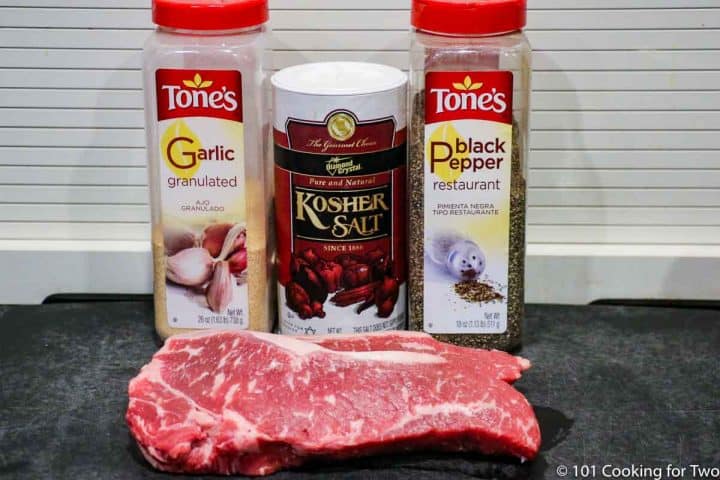
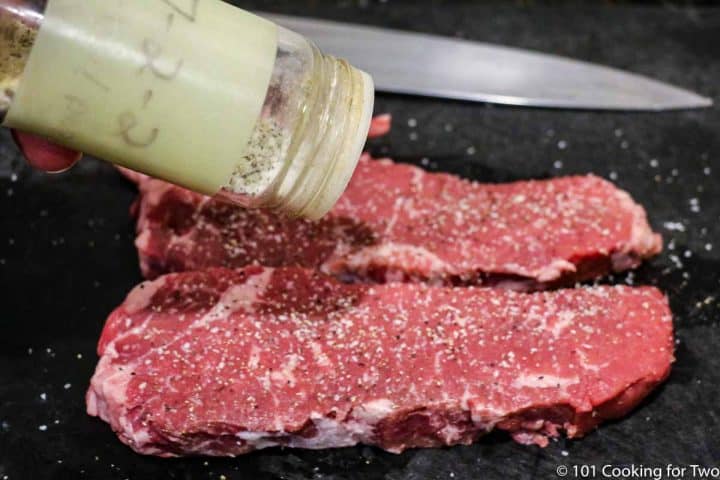
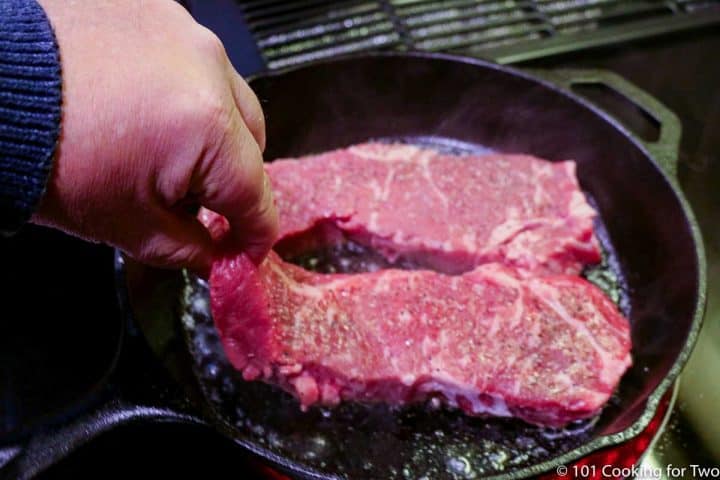
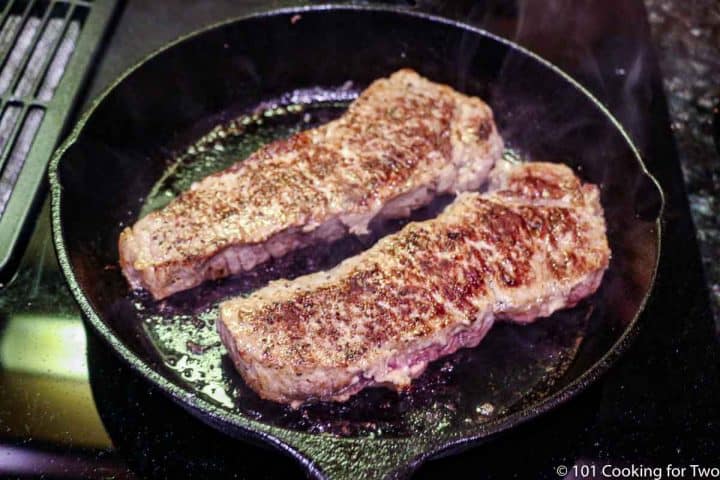
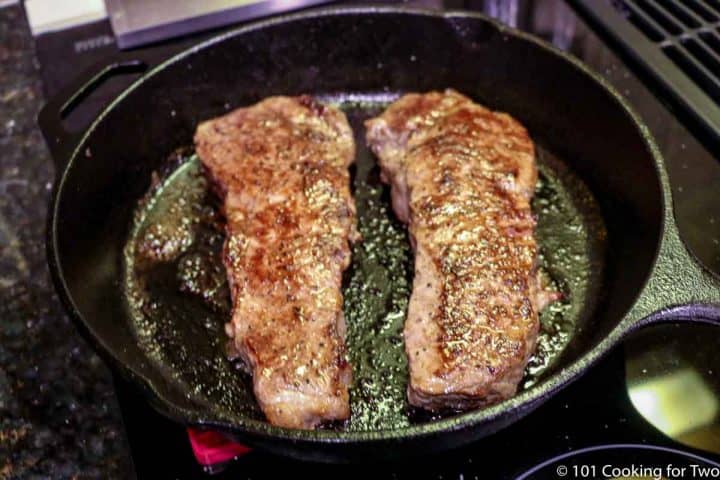
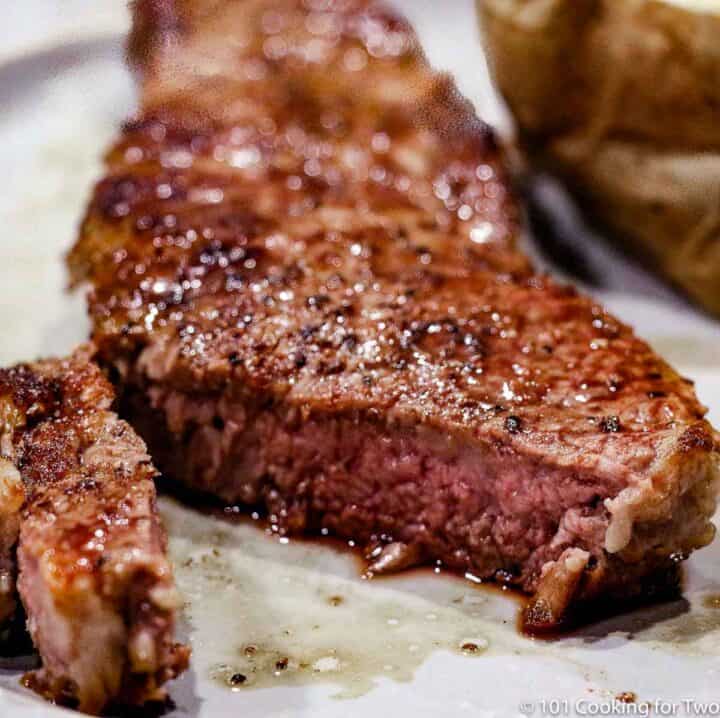
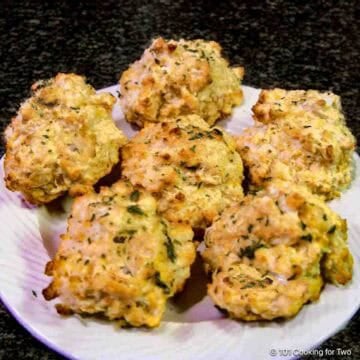
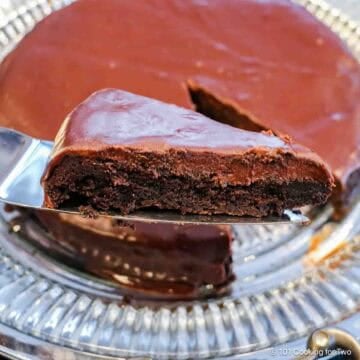
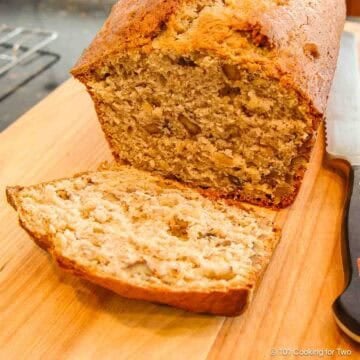

Jonathan says
Thanks for the advice, ill try it out. I really need the thermometer you guys say I need to invest in. I have a few electronic ones but I don't like them. Thanks for the help and tips.
Jonathan Pattee says
Normally Chuck roast. I have not purchased one from a butcher shop. Either way, I would prefer your advice. I am always open to suggestions.
DrDan says
I personally prefer a chuck roast due to the marbling. Other than cutting it up for various uses, straight cooking of a chuck roast I aways do using this recipe https://www.101cookingfortwo.com/wifo-pot-roast-basic-comfort-food/ I have experienced with some searing several years ago but it didn't seem needed, more of a waste of time for me and made my wife mad since I was screwing with her pot roast. Using this recipe, it is moist and tender. The surface gets hot enough for a Maillard reaction hence searing didn't do much.
Outside of that, I don't sear things like a ribeye roast or eye of round since I have butter all over it. Cooks Illustrated does do a fair amount of searing of roasts. I have done a eye of round but I felt it made the surface too dry so I now go the butter route. I just don't cook large chunks of meat that often.
So I'm not too helpful for you. You might want to read about reverse searing methods. I haven't done much with it but I might be an answer for you.
Dan
Jonathan Pattee says
I will have to admit, I have been on several sites looking for a good cast iron steak recipe and this is what I will use tonight. DrDan is so knowledgeable, that I read all of the post. I don't do this normally, but he fired back at all of the sniper questions with great knowledge. I upgraded to a pioneer woman cast iron an am eager to try this out with potatoes and asparagus. Off topic, if you are this good at steak do you have a roast sear recipe? I gave up on roast because mine always becomes dried out.
DrDan says
Hi Jonathan,
First thanks for the note and the compliments. I try to be polite about these things.
What type of roast are you talking about?
Dan
Mark says
So how would this translate to a well done steak? I'm not overly fond of the red on the inside due to my upbringing, but I love well done steak.
Whenever I attempt to cook the steak well enough for me to enjoy, it just ends up.. burnt.
DrDan says
Hi Mark,
Well done is in the 160 range. Most of the pink will disappear about 155. 165 is definitely well done and may be more than you want.
If I was aiming for that range of temperature, I would first be sure to let the meat set at room temperature for about 60 minutes before starting. That will make it much easier to get the internal temperature you want without burning the exterior.
Next is thickness. This will be harder with thicker steak. If you go over one inch it will be very difficult.
Last, you must have a good instant read meat thermometer. Remove from the oven a few degrees less than your target. Tent lightly for about 5 minutes.
One last thought, since you will be cooking a bit longer (probably about 2 minutes I think), you will be more likely to have the butter start smoking. I suggest using oil. Then a pat of butter on top when you tent.
Hope that helps
Dan
Jeff says
Absolutely perfect! I could not grill, no burn order and I have five acres of dry grass just waiting to be on fire. I was skeptical didn't want to waste some nice strip steaks but this technique worked perfectly for me. Thank you for sharing!!
lisa says
It pains me to do it, but I will make this for my husband. I am a vegetarian. And although he is eating much less meat these days, he likes a good steak once in a while. With the rave reviews, I'm sure he will love it. Thanks for posting. I will only use free roaming local grass fed however. (Sorry, not from Iowa)
DrDan says
He will love you for it.:)
AMAMLM says
Just used this guide to cook up two NY steaks and they turned out amazing! Thanks for sharing!
Sarah Warner says
I have to say... just reading DrDan’s responses to everyone’s questions made my night! I have made my steaks exactly as he says and they turn out beautifully every time! However, what made me smile is his wit, and what seems to be a very lovely human being behind his words!
Just wanted to say THANK YOU DRDAN for being a nice man in not always such a nice world
Thank you for sharing your wisdom too!
DrDan says
Thanks for the note and compliment. I just try to be helpful. It is the old "golden rule" thing. Also, I don't engage in unnecessary combat like the grass feed thing. Enough has been said about that.
Dan
Estelle Crawford says
This was The Best steak I have ever made.
I followed your instructions to the letter including making certain to tip the pan periodically so the butter swirles during the brief but intense cooking.
The aroma was mouthwTering and the steak was perfect.
Thank you for this 5 star receipe!
Jim says
Your instructions are perfect, but the Grass Fed comments are fake news. Cows are supposed to be eat grass and not stand still all day and eat GMO infused corn.
Taylor says
There's a definite difference in taste between grass and grain fed cows! I work for an Internet based meat company (we sell and ship mostly gourmet beef (Wagyu, Japanese Wagyu Kobe beef etc) pork and some chicken from local farms) and from customer responses and personal experience grass fed cattle beef has a *gamey* taste more like deer venison, and grain fed beef does not have that gamey flavor. Some prefer the grass while some prefer the grain fed. It's not fake news, but a fact
DrDan says
Hi Taylor and welcome to the blog.
Well said. I will not buy grass feed. Fortunately, they are proud of it and label it well.
I tend not to reply to comments like Jim's. We each have an opinion and I see no need to engage and this is not the place for a GMO debate.
Thanks again for the note.
Dan
Eastclif says
Gordon Ramsay starts with olive oil, but near the end throws butter in, and when it melts, he tilts the pan, and spoons it over and over and over the steaks. (he doesn't do the oven method, but I thought this might help the people worried about the smoking butter )
I.L.Davis says
I ama New Yorker in the Charolais region of France. I have a 3 pound porterhouse
I wish to sear and roast . I am getting all kinds of mixed messages relative to proper cooking. I have been told to sear for 4 minutes / side and then roast at 425f
For 10-12 minutes. Then Inhavw been also toldd to sear for two minutes,/ side and then roast at 400f for 8-10 minutes ON EACH SIDE. Help !
DrDan says
Now that is a large porterhouse. Start looking at it as what you want at the end not just techniques that people tell you. You want a nice sear on the meat and you have a desired internal temperature you want when done.
Part of the issue is the bone. When you pan sear, it will shrink the meat so the meat near the bone will not be in contact with the pan. That is ok but just realize it won't sear in those areas. So I tend to do bone-in things on a grill.
But let proceed with discussing doing stovetop to oven. First and probably the most important step will be resting to room temperature before starting. Next preheat oven, anywhere from 350 to 425. The exact temp of the oven is probably not that important but the thicker the meat, the LOWER I would use, it will just take longer for the heat to penetrate the meat. So lower temp and longer time for thicker meat. Obviously an oven safe pan.
Sear both sides for a few minutes to get to approximately the final sear you want.
Now you are ready for the oven. Do a final flip just before the oven. Then roast to a few degrees less than you want. Remove to plate and tent for 10 minutes. Done.
Another option is called reverse searing. Basically, you do the oven part first and then sear. I have never done this and I don't know the temperature you use as the oven endpoint.
If grilling, again rest to room temp. Then grill over medium heat, not high, on the grill like my grilled filet recipe. But it may take multiple flips.
Janet says
I agree on the oil vs butter searing. Save the butter for finishing/resting. Great flavor. I've been doing steaks this way for 20 or more years when it's either too hot or too cold to grill. Works every time!
Karen says
I just cooked NY strip steaks using your method. I'm confident that the next time I do it using a different source for the beef they will turn out wonderfully (these were grass-fed which I've eaten before from a different supplier and they were delicious, but tonight's are dryish and chewy even though I cooked them to medium rare.) My question, since my freshly DrDanned cast iron skillet is staring me in the face, is how do YOU clean yours after it has had butter and sticky garlic seared and baked onto it??, without destroying its seasoning?
DrDan says
Officially, you use hot water with a sponge or stiff brush. Never soaps or steel wool. You can get special scrubbers that look like chain mail.
Now how do I do it? I use hot water and 3M scrub pads. I do occasionally use a little dish soap if needed but try to avoid it. I then immediately dry with a paper towel then a light spray of PAM that I spread with the paper towel. I have never had any rust and the seasoning is fine.
I must admit to my sins but I have gotten away with it for 5 years. Also I wash my knives in the dishwasher. The shame of it all...
Rebecca says
Quick question on the oven roasting component - how do you prevent butter or oil from "popping" out of the pan once it's in the oven? Isn't there a grease fire risk? Or do you pour off the excess before switching from stovetop to oven? I've considered covering the pan, but I think the steam would impact the texture in a negative way.
DrDan says
Hi Rebecca,
It has never been a problem for me. Be sure your pan has some sides. If you're concerned then remove any free fluid. Do not cover, it will get the steam effect.
Thanks for the note.
Dan
Rune Gosta says
I don't like grass fed...... haha. I think what you mean is I don't like beef the way it's supposed to taste.